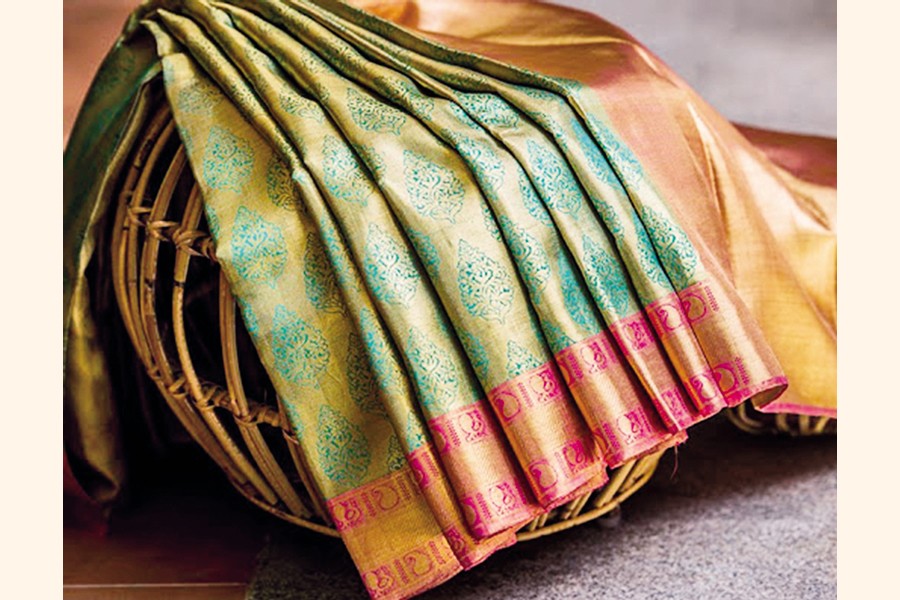
Published :
Updated :

When asked about the silk mania in the market, trying to source the reason with quite a bit of difficulty thinking, the sellers answered, "Egula chole beshi" (they are popular). Delicate cotton is rare; those premium Muslins that could easily pass through rings worn on fingers reside now in Shahbag's National Museum archives as testaments of history. Nevertheless, that creation has yet to be found. Time sure changes what goes around - as a nod to that, cotton has become an increasingly luxurious fabric with time, whereas the silk blended variations have made their places in our closets.
Silk is washable, durable, elegant, and looks better when blended than pure cotton textiles. Thus, preparations of sarees centre around the fabric. The production of silk or sericulture has a historic status in Bangladesh. But the demand has grown too much in the past two decades. As local supplies could not meet the increasing demand, importing silk and silk products became a norm. The variety of silk ranges depending on the type and construction of a product. Half-silk Jamdani saree consists of fifty per cent silk weaved together with cotton. Many sellers in the market call out for 'Dhakaiya Jamdani' by presenting silk and cotton-infused Jamdani sarees.
When we think of 'Rajshahi Silk,' we immediately set high standards for the fabric. The silk fabric is lustrous and practically steals the show, particularly on occasions meant for some dazzling. In the run with the contender fabric cotton, silk has withstood the demand for itself for its buttery, shiny effect, even more so in this age of social media when camera clicks are far more descriptive of the state of mind. The robust textile, when mixed with cotton to produce the widely popular range of half-silk sarees, becomes indistinguishable from the cotton counterparts but helps bring the visual effect upon the sarees, which is the key behind the popularity of silk sarees.

The blending of silk is just a variation of the original Dhakaiya Jamdani, the latter being less shimmery but unique and intricate as a product. A better specification to describe the blending of silk into sarees is telling them handloom silk-infused sarees. Nevertheless, the Jamdanis weaved and sold out to the sellers should be somewhat photogenic. The original Jamdanis tended to be simple yet sophisticated; gone are those days, as we have widely accepted the silk-blended Jamdanis for a while. Half-silk Jamdani saree, especially when the count of the saree is higher (around 60), delivers an aristocratic polish.
In the eighteenth century, when silk grew to prominence, half-silk started rising and making its place as a mainstay fabric in the looms, and its roots can be traced back to England. Blended silk is another buzzword synonymous with half-silk; additionally, the saree is likely not a Jamdani or the alternating fibre mixed with silk is likely not cotton. Silk merely leaves space for experimentation on traditional fabrics like Muslin, Linen or Cotton Voile, and depicting eye-catching patterns on them is the vogue now happening countrywide.
Although Dhaka, Narayanganj and Sonargaon famously hold the status of originating places of the traditional fabrics and weaving techniques that made Bengal a worldwide famous phenomenon in clothing, the charm is not in enclosed history. Despite being a suitable country to adapt to sericulture, Bangladesh maintains close ties with India, a neighbouring trader of various silk fabrics. Indian sarees have been dominating the Dhaka markets both in the wholesale and retail sectors. The primary reasons behind the trend are the affordability and availability of Indian silk sarees and Bangladesh's silk shortcomings.
The visual appeal of silk goes very well with the smartphone pleasure we spread when we treat ourselves with fresh clothes. Many argue that cotton is the fabric that goes with the Bangladeshi weather. Silk, a heavier fabric, does not sit away but got into our culture from neighbouring cultures, and silk-blending is our own now.


 For all latest news, follow The Financial Express Google News channel.
For all latest news, follow The Financial Express Google News channel.